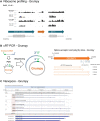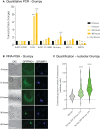A long noncoding RNA promotes parasite differentiation in African trypanosomes
- PMID: 35704590
- PMCID: PMC9200285
- DOI: 10.1126/sciadv.abn2706
A long noncoding RNA promotes parasite differentiation in African trypanosomes
Abstract
The parasite Trypanosoma brucei causes African sleeping sickness that is fatal to patients if untreated. Parasite differentiation from a replicative slender form into a quiescent stumpy form promotes host survival and parasite transmission. Long noncoding RNAs (lncRNAs) are known to regulate cell differentiation in other eukaryotes. To determine whether lncRNAs are also involved in parasite differentiation, we used RNA sequencing to survey the T. brucei genome, identifying 1428 previously uncharacterized lncRNA genes. We find that grumpy lncRNA is a key regulator that promotes parasite differentiation into the quiescent stumpy form. This function is promoted by a small nucleolar RNA encoded within the grumpy lncRNA. snoGRUMPY binds to messenger RNAs of at least two stumpy regulatory genes, promoting their expression. grumpy overexpression reduces parasitemia in infected mice. Our analyses suggest that T. brucei lncRNAs modulate parasite-host interactions and provide a mechanism by which grumpy regulates cell differentiation in trypanosomes.
Figures








References
-
- Vassella E., Reuner B., Yutzy B., Boshart M., Differentiation of African trypanosomes is controlled by a density sensing mechanism which signals cell cycle arrest via the cAMP pathway. J. Cell Sci. 110, 2661–2671 (1997). - PubMed
LinkOut - more resources
Full Text Sources
Other Literature Sources

